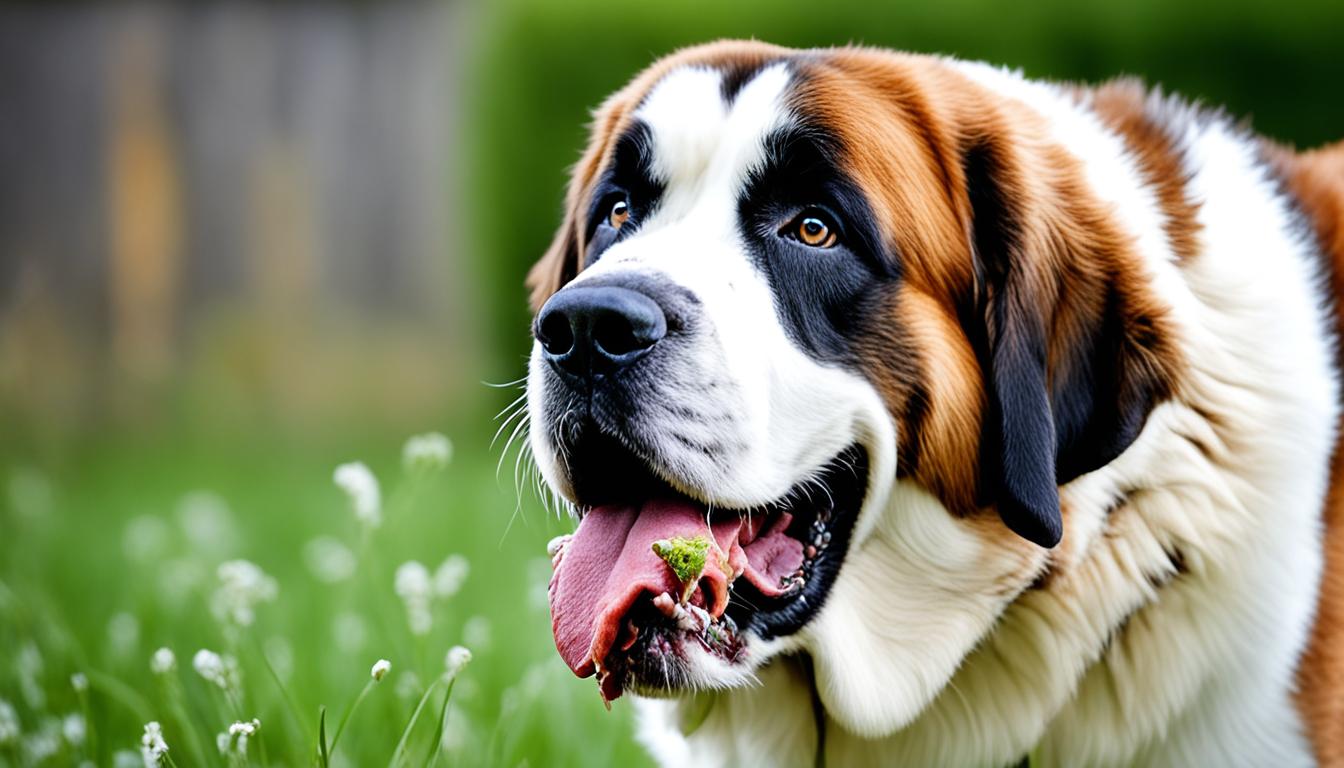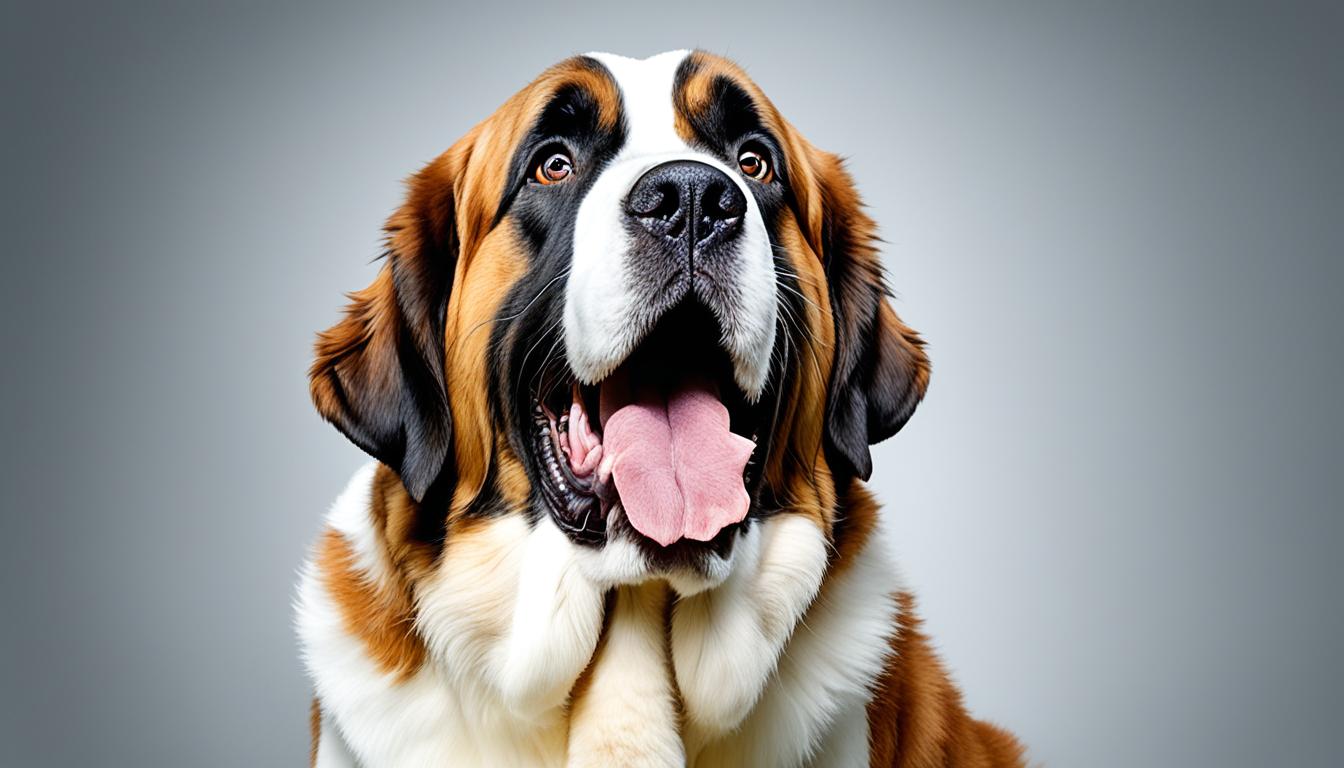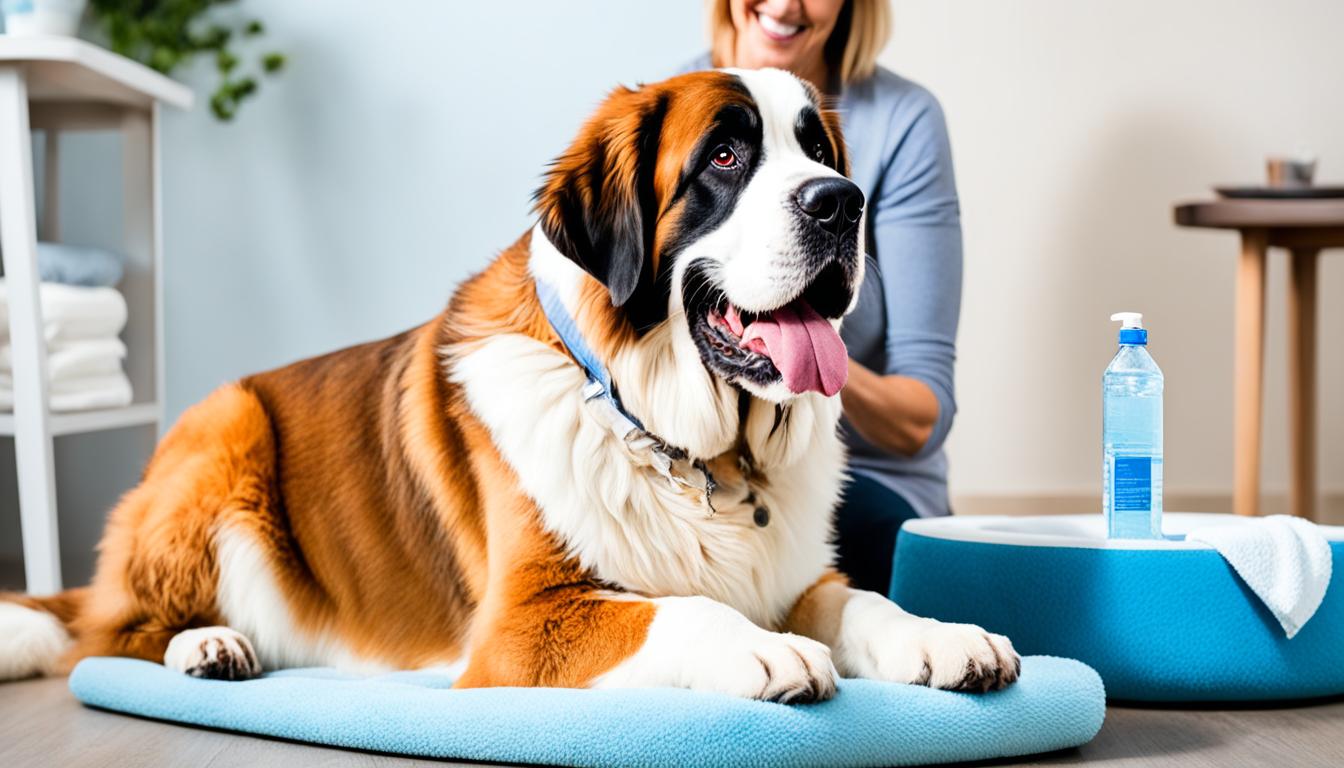If you have a Saint Bernard, you’re probably familiar with their endearing and sometimes messy trait – drooling. While drooling is a natural occurrence for this gentle giant breed, excessive drooling can sometimes be a cause for concern. In this section, we will explore the causes of Saint Bernard drooling and provide you with practical tips to manage it effectively.

Key Takeaways:
- Excessive drooling is a common characteristic of Saint Bernards but can sometimes indicate health issues.
- Causes of drooling in Saint Bernards include genetics, anatomy, temperature, and excitement levels.
- Regular grooming, using drool cloths, and maintaining a well-balanced diet can help manage drool.
- Modifying your home and using training techniques can minimize the impact of drool.
- Consulting a veterinarian is important if your Saint Bernard’s drooling becomes excessive or concerning.
The Nature of Saint Bernard Drool
When you think of Saint Bernards, one of the first things that may come to mind is their massive size and, of course, their drooling nature. Drooling is a common characteristic of this gentle giant breed, and it’s important to understand the natural tendencies behind it.
Saint Bernards have large jowls and lips, which contribute to their drooling habit. These extra folds and loose skin around their mouths allow saliva to accumulate and escape more easily. Additionally, their history as rescue dogs in the Swiss Alps may have influenced this trait.
Their drooling nature serves a purpose when they are working in cold, snowy conditions. The moisture from their drool helps protect their skin from the freezing temperatures and acts as an insulating barrier. It’s fascinating how these dogs have adapted to their environment over the years.
“The natural tendency of Saint Bernards to drool is a result of their anatomy and their history as rescue dogs in the Swiss Alps.”
While Saint Bernard drool can be messy and inconvenient at times, it’s important to remember that it’s a part of who they are. Embracing this characteristic and understanding its nature can help you appreciate your furry companion even more.
Drool Comparison: Saint Bernard vs. Other Breeds
| Breed | Drooling Level |
|---|---|
| Saint Bernard | High |
| Bulldog | Medium |
| Bloodhound | High |
| Newfoundland | Medium |
| Mastiff | High |
Note: The drooling level may vary among individual dogs within each breed.
Why Do Saint Bernards Drool?
Saint Bernards are known for their gentle nature and their tendency to drool excessively. If you’ve ever wondered why these lovable giants leave a trail of slobber wherever they go, there are several factors that contribute to their unique drooling habits.
Genetics
Genetics plays a significant role in why Saint Bernards drool. The breed’s ancestors, the Molosser dogs, were large breed companions who were known for their slobber. Over time, this trait was passed down to the Saint Bernard breed, resulting in their propensity for excessive drooling.
Anatomy
The anatomy of Saint Bernards also contributes to their drooling. These dogs have loose, jowly skin around their mouths, which makes it more difficult for them to control their slobber. Their large, open mouths and loose lips further add to the drooling equation.
Temperature
Temperature can also play a role in a Saint Bernard’s drooling. When the weather is hot, these dogs may drool more to regulate their body temperature. Drooling helps to cool down their mouths and prevent overheating.
Excitement Levels
Another cause of excessive drooling in Saint Bernards is their excitement levels. When they become excited, whether it’s due to seeing their favorite humans or engaging in a fun activity, their salivary glands kick into overdrive, resulting in a slobber fest.
Understanding the causes of excessive drooling in Saint Bernards can help you better manage and cope with this natural behavior. By implementing grooming techniques, providing adequate cooling measures in hot weather, and keeping a drool cloth handy, you can embrace your slobbery companion while still maintaining a clean and comfortable living environment.

Health Issues Related to Excessive Drooling
While excessive drooling is a common characteristic of Saint Bernards, it is essential to be aware of potential health issues that may contribute to this behavior. In some cases, excessive drooling can be a sign of an underlying medical condition that requires veterinary attention.
Here are some health issues that may be associated with excessive drooling in Saint Bernards:
- Gingivitis and Periodontal Disease: Poor dental hygiene can lead to gum inflammation and oral infections, resulting in excessive drooling. Regular dental care is crucial for maintaining your Saint Bernard’s oral health.
- Mouth and Throat Infections: Infections in the mouth or throat can cause discomfort and increased saliva production, leading to excessive drooling. These infections may be caused by bacteria, viruses, or fungal pathogens.
- Oral Tumors: Although rare, oral tumors can develop in Saint Bernards, affecting their ability to swallow properly and increasing drooling. It’s essential to monitor any lumps or abnormalities in your dog’s mouth and seek veterinary advice if necessary.
- Digestive Issues: Certain gastrointestinal conditions, such as acid reflux or megaesophagus, can cause excessive drooling in Saint Bernards. These conditions affect the dog’s ability to swallow food properly and may result in regurgitation and increased saliva production.
- Heat Exhaustion: Saint Bernards are prone to heatstroke due to their thick coats and susceptibility to overheating. Heat exhaustion can cause excessive drooling as the dog tries to regulate its body temperature. It is crucial to keep your Saint Bernard cool and well-hydrated, especially during hot weather.
If you notice any of the following signs along with excessive drooling in your Saint Bernard, it is recommended to consult a veterinarian:
“Persistent bad breath, swollen or bleeding gums, difficulty eating or swallowing, lumps or growths in the mouth, signs of pain or discomfort, frequent regurgitation, and increased drooling unrelated to excitement or temperature changes.”
A veterinarian will be able to examine your dog thoroughly, diagnose any underlying health issues, and provide appropriate treatment options. Remember, early detection and intervention can help prevent further complications and ensure the well-being of your beloved Saint Bernard.
Health Issues Related to Excessive Drooling in Saint Bernards
| Health Issue | Description |
|---|---|
| Gingivitis and Periodontal Disease | Poor dental hygiene leading to gum inflammation and oral infections. |
| Mouth and Throat Infections | Infections in the mouth or throat causing discomfort and increased saliva production. |
| Oral Tumors | Development of tumors affecting swallowing and increasing drooling. |
| Digestive Issues | Gastrointestinal conditions affecting swallowing and saliva production. |
| Heat Exhaustion | Overheating leading to increased drooling as a mechanism to cool down. |
Tips for Managing Saint Bernard Drool
Managing drool is an important aspect of Saint Bernard ownership. These gentle giants are known for their excessive drooling tendencies, but with the right approach, you can keep the drool under control and create a more comfortable environment for both you and your furry friend. Here are some practical tips and tricks to help you manage Saint Bernard drool:
- Regular Grooming: Keep your Saint Bernard’s facial area clean by gently wiping away drool with a soft cloth or paw wipes. Regular grooming helps prevent the build-up of dried drool and keeps your dog’s skin healthy.
- Use Drool Cloths: Keep a supply of absorbent cloths handy to quickly wipe away drool throughout the day. Place the cloth strategically near your dog’s resting areas, so you can easily access it when needed.
- Provide a Well-Balanced Diet: The quality of your dog’s diet can impact the consistency and volume of their drool. Consult your veterinarian to ensure your Saint Bernard is receiving a nutritionally balanced diet that supports their overall health.
Remember, managing Saint Bernard drool requires consistency and patience. Implementing these tips will help you reduce the mess and maintain a cleaner living space.
Grooming and Managing Saint Bernard Drool
Grooming plays a vital role in managing Saint Bernard drool effectively. By following a regular grooming routine, you can keep your dog clean and comfortable while minimizing the impact of drooling. Here are some additional grooming tips to consider:
- Brush your Saint Bernard’s coat regularly to remove loose fur and prevent tangles or matting.
- Pay special attention to the facial area, cleaning the folds of skin and ensuring there are no signs of irritation or infections.
- Trim your dog’s facial hair carefully to prevent excessive drool accumulation around the mouth.
By incorporating these grooming practices into your routine, you can effectively manage Saint Bernard drool and keep your furry companion looking and feeling their best.
| Grooming Tips for Managing Saint Bernard Drool | Description |
|---|---|
| Regular Grooming | Brush your Saint Bernard’s coat regularly to remove loose fur and tangles. |
| Clean the Facial Area | Pay special attention to cleaning the folds of skin around the mouth to prevent irritation or infections. |
| Trim Facial Hair | Trim your dog’s facial hair carefully to minimize drool accumulation. |
Making Your Home More Drool-Friendly
Living with a lovable Saint Bernard comes with its fair share of drool. But worry not! With a few simple home modifications and strategic furniture choices, you can create a drool-friendly environment that is easier to clean and maintain.
One essential step in creating a drool-friendly home is investing in furniture that is resistant to drool stains and easy to clean. Opt for materials like leather or microfiber, as they are less absorbent and can be wiped clean effortlessly. Consider getting machine-washable covers or slipcovers to protect your furniture from drool and make cleaning a breeze.

In addition to furniture, it’s important to pay attention to your flooring. Hardwood or tiled floors are ideal as they can be easily mopped or wiped down. If you prefer carpeting, choose stain-resistant options or place protective mats in areas where your Saint Bernard tends to drool the most.
Another practical tip is to designate a drool zone or corner in your home. This area can be equipped with a comfortable bed or mat for your Saint Bernard, along with easily washable blankets or covers. By confining the drooling to a specific area, you can minimize the impact on the rest of your home.
When it comes to maintaining a drool-friendly home, quick and regular cleaning is key. Keep a stash of absorbent towels or drool cloths within easy reach so you can quickly wipe away drool before it has a chance to spread. Establish a daily cleaning routine to ensure that drool is promptly cleaned up, preventing stains and odors from becoming a problem.
Remember, creating a drool-friendly home is all about finding practical solutions that work for you and your furry friend. By implementing these modifications and making smart furniture choices, you can create a comfortable and clean living space that accommodates your Saint Bernard’s drool while still reflecting your personal style.
Training Techniques to Reduce Drooling
Training your Saint Bernard to minimize excessive drooling can significantly improve your daily interactions and ensure a cleaner home environment. By employing the right techniques during specific situations, such as mealtime or interactions with visitors, you can help your gentle giant manage their drooling tendencies.
1. Mealtime Training
During mealtime, excessive drooling can be particularly bothersome. Use positive reinforcement techniques to teach your Saint Bernard to sit calmly and wait for their food without drooling excessively. Start by withholding the food bowl until your dog is calm and composed. Reward them with a treat or praise when they exhibit non-drooling behavior. Repeat this training consistently to establish good mealtime manners.
2. Distraction Techniques
To distract your Saint Bernard from drooling triggers, engage them in activities that require mental stimulation and focus. Puzzle toys, interactive treat dispensers, or obedience training exercises can divert their attention, reducing drooling episodes. Remember to reward calm behavior with treats or praise.
3. Socialization Training
Saint Bernards often drool excessively when they encounter new people or pets. Gradual socialization and desensitization training can help reduce their anxiety and subsequently decrease drooling. Introduce your dog to new environments, visitors, and other animals in controlled settings. Reward calm behavior and gradually increase the challenge as they become more comfortable.
“Training your Saint Bernard to control their drooling can enhance their overall quality of life and make bonding with them even more enjoyable.”
– Dr. Emily Thompson, Canine Behavior Expert
4. Verbal and Visual Cues
Teach your Saint Bernard verbal and visual cues to signify when drooling behavior is unacceptable. Use consistent commands such as “No drooling” paired with a hand signal or gesture to catch their attention. Reward them when they respond correctly and reinforce the desired behavior over time.
| Training Technique | Description |
|---|---|
| Mealtime training | Teach your Saint Bernard to wait calmly for their food without excessive drooling. |
| Distraction techniques | Engage your dog in mentally stimulating activities to divert their attention from drooling triggers. |
| Socialization training | Gradually expose your dog to new people, animals, and environments to reduce anxiety-related drooling. |
| Verbal and visual cues | Use consistent commands and gestures to signal that drooling behavior is not acceptable. |
Be patient and consistent with your training efforts. It may take time for your Saint Bernard to learn and adapt to these techniques, but with dedication and positive reinforcement, you can help reduce their drooling habits effectively.
Grooming Tips for Saint Bernard Drool
Proper grooming is essential to keep your Saint Bernard’s mouth and facial area clean and well-maintained, preventing discomfort and infections associated with excessive drooling. Follow these grooming tips to ensure your gentle giant stays happy and healthy.
Grooming Supplies:
Before you begin grooming, gather the necessary supplies:
- Soft-bristle brush
- Fine-toothed comb
- Grooming wipes
- Baby wipes
- Ear cleaning solution
- Dog-safe toothbrush and toothpaste
- Treats as positive reinforcement
Grooming Routine:
Follow this grooming routine to keep your Saint Bernard clean and fresh:
- Brushing: Regularly brush your Saint Bernard’s fur to remove loose hairs and prevent matting. Pay special attention to the facial area where drool accumulates. Brush gently to prevent discomfort.
- Cleaning the Facial Area: Use grooming wipes or baby wipes to clean your Saint Bernard’s mouth, chin, and jowls. This helps remove excess drool and prevent skin irritation. Be gentle and thorough, paying attention to folds and creases.
- Ear Care: Clean your Saint Bernard’s ears regularly to prevent infection. Use a dog-safe ear cleaning solution and cotton pads to gently wipe the outer part of the ear. Avoid inserting anything into the ear canal.
- Dental Hygiene: Maintain your Saint Bernard’s dental health by brushing their teeth regularly. Use a dog-safe toothbrush and toothpaste to prevent tartar buildup and keep their breath fresh. Start slowly and gradually increase the duration of brushing sessions.
Professional Grooming:
In addition to regular grooming at home, consider taking your Saint Bernard to a professional groomer for occasional deep cleaning. They can trim the fur around the facial area and ensure your dog’s overall hygiene.
Remember to reward your Saint Bernard with treats and praise during grooming sessions to create a positive experience. Gradually introduce grooming activities from a young age to establish a routine and make it more enjoyable for both of you.
Proper grooming is not only essential for your Saint Bernard’s appearance but also for their overall well-being. Regular grooming can help prevent discomfort and keep your gentle giant healthy and happy.
How to Handle Saint Bernard Drool
When it comes to owning a Saint Bernard, it’s no secret that drool is a part of the package. While their drooling nature is something to be embraced, managing the mess and discomfort that can come with it is essential for both you and your gentle giant. Here are some practical tips to help you handle Saint Bernard drool effectively:
- Keep drool cloths handy: Always have a supply of absorbent cloths or towels within reach. This way, you can quickly and easily wipe off any excess drool from your Saint Bernard’s mouth or face.
- Use a drool bib: Consider investing in a specially designed drool bib that can be worn by your Saint Bernard during mealtime or while indoors. This can help contain the drool and prevent it from getting on furniture or your floors.
- Regular grooming: Maintain a consistent grooming routine for your Saint Bernard, focusing on keeping their mouth and facial area clean. This can help reduce the discomfort caused by excessive drooling and minimize the risk of skin infections.
- Maintain dental hygiene: Good oral care is essential for Saint Bernards, as it can help control drooling. Brush your dog’s teeth regularly using a toothbrush and toothpaste recommended by your veterinarian.
- Protect furniture and surfaces: Consider covering furniture with protective covers or using drool-resistant materials that are easy to clean and maintain. Use washable mats or rugs to protect your floors from drool stains.
- Stay prepared outdoors: When taking your Saint Bernard for walks or outdoor adventures, carry a small towel or wet wipes to wipe off any drool that may accumulate during the trip. This will help keep them comfortable and prevent drool from getting on other people or their pets.
- Stay calm: Remember that excessive drooling is a natural characteristic of Saint Bernards. Avoid getting frustrated or agitated by their drooling and instead focus on managing it with patience and understanding.
By implementing these tips, you can handle Saint Bernard drool more effectively, keeping the mess to a minimum and ensuring the comfort of both you and your beloved gentle giant.
Consulting a Veterinarian for Drooling Concerns
While occasional drooling is normal for Saint Bernards, excessive drooling can be a cause for concern. If you notice that your furry friend’s drooling has become excessive and persistent, it may be necessary to consult a veterinarian. These professionals can help identify and address any underlying issues causing the excessive drooling.
It’s important to remember that not all drooling concerns in Saint Bernards require immediate medical intervention. However, certain situations warrant a visit to the vet to ensure your pet’s health and well-being. Below are some scenarios where seeking veterinary advice is recommended:
- If your Saint Bernard experiences sudden and significant changes in drooling patterns
- When the drool becomes consistently thick, stringy, or changes in color
- If your Saint Bernard exhibits signs of discomfort or pain associated with excessive drooling
- When drooling is accompanied by other concerning symptoms, such as lethargy, loss of appetite, or difficulty swallowing
A veterinarian will be able to conduct a thorough examination of your Saint Bernard and may perform additional tests if necessary. They will consider various factors, including your pet’s medical history, breed-specific tendencies, and any identifiable triggers or symptoms. Based on their evaluation, the veterinarian can provide a tailored treatment plan to address your Saint Bernard’s drooling concerns.
Note: Always consult a veterinarian to rule out any potential health issues causing excessive drooling in your Saint Bernard.
Remember, as a pet owner, you play a crucial role in monitoring your Saint Bernard’s health. Being proactive and seeking veterinary advice for drooling concerns can help ensure your pet stays happy, healthy, and comfortable.
Conclusion
In conclusion, understanding the causes of Saint Bernard drooling is crucial for effectively managing this common characteristic of the breed. By recognizing the natural tendencies and factors that contribute to excessive drooling, you can take proactive measures to minimize its impact on your daily life.
Throughout this article, we have explored various tips and techniques to help you cope with Saint Bernard drool. Regular grooming, drool cloths, and a well-balanced diet are just a few strategies you can implement to keep your home cleaner and more drool-friendly.
Additionally, training methods can be used to teach your Saint Bernard to reduce drooling during specific situations, such as mealtime or when visitors are present. Consistency and patience are key to successfully modifying your dog’s behavior.
Remember, if you notice any signs of excessive drool that could indicate underlying health issues, consulting a veterinarian is recommended. They can provide expert guidance and ensure your beloved Saint Bernard receives the appropriate care.
FAQ
What causes Saint Bernard drooling?
The main reasons behind Saint Bernard drooling include genetics, anatomy, temperature, and excitement levels. These factors can all contribute to excessive saliva production in this breed.
Is excessive drooling in Saint Bernards a sign of health issues?
Excessive drooling can sometimes indicate underlying health conditions in Saint Bernards. If you notice a sudden change in drooling patterns or other concerning symptoms, it is recommended to consult a veterinarian for further evaluation.
How can I manage Saint Bernard drool?
Managing Saint Bernard drool can be achieved through regular grooming, using drool cloths, and providing a well-balanced diet. These practices can help minimize the impact of drool on your living space and keep your Saint Bernard comfortable.
Are there any home modifications that can help with Saint Bernard drooling?
Making certain modifications to your home, such as choosing drool-friendly furniture and implementing easy-to-clean flooring options, can make it easier to manage and maintain cleanliness despite the drool from your Saint Bernard.
How can I train my Saint Bernard to drool less?
Training techniques can be used to teach your Saint Bernard to minimize excessive drooling during specific situations. Consistency, positive reinforcement, and redirection tactics can help achieve this goal.
How should I groom my Saint Bernard’s mouth and facial area to prevent discomfort?
Regularly cleaning your Saint Bernard’s mouth and facial area with gentle wipes or a damp cloth can help prevent discomfort or infections related to excessive drooling. Additionally, maintaining good oral hygiene by brushing their teeth regularly is important.
How can I handle Saint Bernard drool to minimize mess?
Handling Saint Bernard drool can be made easier by keeping drool cloths or towels handy, wiping their mouth regularly, and teaching your dog to sit or lay on a designated drool-friendly mat or area.
When should I consult a veterinarian about my Saint Bernard’s drooling?
If you observe any sudden changes in your Saint Bernard’s drooling patterns, such as an increase in quantity or frequency, or if it is accompanied by other concerning symptoms, it is advisable to consult a veterinarian to rule out any underlying health issues.
Any final thoughts on managing Saint Bernard drool?
By understanding the nature of Saint Bernard drooling and implementing the suggested strategies, you can effectively manage and minimize the impact of drool in your home. Remember to consult a veterinarian for any concerns regarding your dog’s drooling, ensuring their health and well-being.


